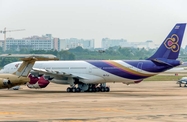In a move widely regarded as a major policy u-turn, the Thai government is paving the way for the relocation of low-cost carriers (LCCs) from Bangkok’s primary airport, Suvarnabhumi, to alternative facilities at the older Don Mueang International Airport as it looks to tackle the growing problem of passenger congestion.
Low-cost passenger movement at Suvarnabhumi reached 7.4m last year, forcing the government to rethink its plans to shift all commercial flights to the main airport and convert Don Mueang into a maintenance facility, at least in the short term.
The controversial decision has caused concern among domestic LCCs, raising fears they will lose business and become caught up in a new phase of political policy reversals.
While the government acknowledges that rising passenger numbers and a lack of capacity at Suvarnabhumi have made the setting up of a single air hub for the city unrealistic at present, it has been keen to challenge claims that the latest move marks the beginning of a de facto dual-airport strategy.
Addressing the public in March, the minister of transport, Jarupong Ruangsuwan, said, “Don Mueang airport will continue for the near future. It’s clear that the single-airport policy isn’t practical due to the problems of congestion. I don’t want to say we are adopting a dual-airport policy. But for the long term, we must put Don Mueang to use.”
Until recently, the plan to close Don Mueang as a scheduled services airport following the opening of Suvarnabhumi in 2006 remained in place. However, following the shift in policy, announced shortly after Jarupong took up his post in January, Airports of Thailand (AoT), the state-run enterprise which manages both airports, commenced a BT1.09bn ($33m) rehabilitation programme at the flood-damaged older airport. The decision to shift LCCs to Don Mueang was made just weeks after operations recommenced there in March.
In a bid to convince up to 10 LCCs to move 45 km across the city to Don Mueang and aware that some operators are openly demanding political guarantees, Prime Minister Yingluck Shinawatra asked AoT to put together an incentive package for the carriers. The enterprise has also placed all non-aviation projects on hold to focus on a planned BT60m ($1.9m) upgrade of aviation infrastructure that could be completed within 90 days and would boost both passenger and cargo capacity.
But some LCCs, including Orient Thai Airlines, are unlikely to be easily persuaded. The budget carrier’s founder, Udom Tantiprasongchai, said its three moves between facilities in the last five years had produced significant relocation costs and confusion among passengers. “It is more convenient to operate from Don Mueang than Suvarnabhumi, but the point is that a clear policy is needed. The government shouldn't mention a single-airport approach one day then change later,” he told the Bangkok Post.
Likewise, Tassapon Bijleveld, the chief executive of the country’s largest budget airline, Thai Air Asia (TAA), issued a statement saying that while the government’s proposals would be considered, the company wanted confirmation that the relocation marked an end to policy reversals.
Keen to reassure the carriers, Captain Kanputt Mungklasiri, the general manager of Don Mueang, told OBG that with passenger numbers expected to continue rising at Suvarnabhumi, he was confident the proposed relocation of LCCs was a long-term strategy. The second phase of Suvarnabhumi Airport’s development, which is now slated for completion in 2016 after falling behind schedule, is expected to raise passenger capacity to 65m per year. But with the expansion set to be matched by rapid growth, the authorities are likely to be keen to stave off future congestion problems.
Even with a political guarantee, however, LCCs will have other concerns about how relocation will affect their business, as a senior analyst at the Centre of Asia Pacific Aviation (CAPA), Brendan Sobie, explained. “Moving is a complicated proposition,” he told OBG, “especially for large airlines that have already invested in the new airport.”
In a boost for the government, the president of Thai Airways International (THAI), Piyasvasti Amranand, has lent some support to the relocation proposal, acknowledging that if the carrier goes ahead with an expected move to set up a budget airline, it could be based at Don Mueang. The International Air Transport Association (IATA) has also said it now regards the shift to Don Mueang as the best short-term solution to congestion, despite initially being opposed to the idea of a dual-airport policy. The IATA has made it clear, however, that it believes Thailand should still strive to make Suvarnabhumi the sole air hub for Bangkok by 2030.
The AoT will be hoping that by persuading TAA to shift bases it will be easier to convince the other airlines to follow suit. “We are still negotiating with [TAA] but I feel like there is a likelihood it will accept our proposition [to relocate],” AoT’s president, Anirut Thanomkulbutra, told the Bangkok Post at the end of March.
With negotiations ongoing, any details of incentives on the table are being closely guarded by all parties. Most LCCs, however, are expected to weigh up the pros and cons of relocation, taking into account issues such as connectivity and capacity, alongside the incentives on offer, before making their final decision.

